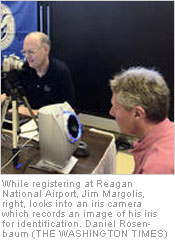by Tom Ramstack, Washington Times
http://washingtontimes.com/business/20040823-091654-6720r.htm
When the program is operating, a special lane at security checkpoints will be reserved for them where they can be identified by looking into a “registered traveler kiosk” for a few seconds. A scanner behind a round hole on the kiosk will probe their eyes for unique characteristics that can be converted to a computer code. If a computer database recognizes their irises and if metal detectors do not identify prohibited items, they can pass through the checkpoints without secondary screening. Unregistered travelers must pass through longer, slower lines at the checkpoints.
“We talk a lot about the needle in the haystack,” TSA spokesman Darrin Kayser said. “This program allows us to move away a lot of the hay.” The “needle” the TSA is trying to find are terrorists..
By letting registered travelers pass through checkpoints to their flights, screeners can focus attention on the rest of the population. Secondary screening, which can include ordering passengers to remove their shoes or passing electronic wands around their bodies, can add three to five minutes to the screening process per person. The agency also intends for the program to respond to complaints by airlines that customer service has suffered in the government’s zeal to stop terrorism.
“It will help the lines to move much more quickly and allow them to get to their flights sooner,” Mr. Kayser said. Similar tests started earlier this summer at airports in Boston, Houston, Los Angeles and Minneapolis. The American Civil Liberties Union criticizes the program as an invasion of privacy that includes loopholes in security.
“Not only are terrorists going to be able to bypass security through forged documentation and fallible technology, the little guy is going to be subjected to the same hassles at the airport while the first-class or business passenger gets a free pass,” Barry Steinhardt, director of the ACLU’s technology and liberty program, said in January.
Electronic Data Systems Corp. (EDS), the information systems contractor for the TSA, set up its equipment yesterday in the baggage claim area at Reagan Airport to register the first volunteers.
American Airlines e-mailed invitations to its most frequent fliers to participate in the program. They must list personal information and volunteer for a photograph and scans of their irises and fingerprints.
Registration is scheduled to continue for about two weeks, until the TSA gets the 2,000 volunteers it seeks at the airport. Their opinions, and the effectiveness of the equipment in identifying them, will guide the agency in developing a similar nationwide registered traveler program.
American Airlines customers signing up as registered travelers yesterday had few concerns about privacy. “I’m not worried,” said Bill Steagall, an IBM computer salesman from Mundeleine, Ill. “They already know all about me anyway. There is no anonymous travel anymore.” He sat at a table answering questions from an EDS clerk, touched his fingers to a fingerprint scanner, had his photograph taken and put his face in front of an “iris camera.” He finished the process by touching a screen at a kiosk, then waited for another scanner to verify his identity through the recorded image of his iris.
Edward FitzMaurice Jr., a National Mediation Board member from Washington, said he thought the convenience and security of the program outweighed privacy issues. “The government has been taking my picture for 40 years,” he said. “It’s apples and oranges.” The special lane for participants in the three-month test is scheduled to be set up by mid-September.
Officials from the Metropolitan Washington Airports Authority, which manages Reagan and Washington Dulles International airports, said most airline passengers were unlikely to notice anything unusual. “It’s not going to be affecting traffic much,” spokesman Tom

